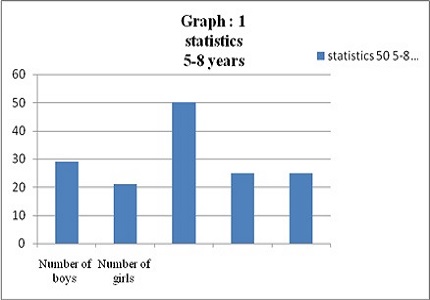Principal motives for tooth brushing among children: implications for oral health promotion -An in vivo study
Abstract
Aim and Objectives: The aim of this study was to assess improvement in motivation for tooth-brushing, the timing of tooth-brushing and the understanding of oral hygiene in children using Tooth Brushing Technique Song as an oral health promotion tool.
Methods: 5-8 year-old children from a tutorial were selected and divided in two groups. Group A was given Tooth Brushing Technique Song and Group B acted as a control. On day one, instructions were given to both groups regarding tooth-brushing, importance of oral hygiene. Two groups of children were assessed after15 days. Results were analyzed and presented using tables, bar charts and pie charts.
Results: Of the 50 children, who remained available for the analysis, 25 children were in group A and 25 were in group B. In group A, approximately 76 % children showed liking towards the song, 68 % could memorize and reproduce the song. Approximately 76% children were motivated to brush after listening to the tooth song. 80% of children always brushed twice daily in group A as compared to 76% in group B.
Conclusion: The happy tooth song had a positive impact on motivation for, the frequency and time of tooth brushing and understanding the importance of healthy food habits and dental visits in children.
Downloads
References
2. World Health Organization The Ottawa Charter for Health Promotion. Health Promotion Geneva. 1986. [PubMed]
3. Rodrigues JA, dos Santos PA, Garcia PP, Corona SA, Loffredo LC. Evaluation of motivation methods used to obtain appropriate oral hygiene levels in schoolchildren. Int J Dent Hyg. 2003 Nov;1(4):227-32. [PubMed]
4. Srivastava N, Vasishat A, Gupta G, Rana V A Comparative Evaluation of Efficacy of Different Teaching Methods of Tooth Brushing in Children. Oral Hyg Health. 2013; 1: 118-122. [PubMed]
5. Gao X, Hamzah SH, Yiu CK, McGrath C, King NM. Dental fear and anxiety in children and adolescents: qualitative study using YouTube. J Med Internet Res. 2013 Feb 22;15(2):e29. doi: 10.2196/jmir.2290. [PubMed]
6. Friel S, Hope A, Kelleher C, Comer S, Sadlier D. Impact evaluation of an oral health intervention amongst primary school children in Ireland. Health Promot Int. 2002 Jun;17(2):119-26. [PubMed]
7. Al-Omiri MK, Al-Wahadni AM, Saeed KN. Oral health attitudes, knowledge, and behavior among school children in North Jordan. J Dent Educ. 2006 Feb;70(2):179-87. [PubMed]
8. Guideline on Caries-risk Assessment and Management for Infants, Children, and Adolescents. Clinical Guidelines. 2009; 36(6): 127-134.
9. Haloi R, Ingle NA, Kaur N Caries Status of Children and Oral Health behavior, knowledge and attitude of their mothers and school teachers in Mathura City. Journal of Contemporary Dentistry .2012; 2(3): 78-83.
10. Sanzone LA, Lee JY, Divaris K, DeWalt DA, Baker AD, Vann WF Jr. A cross sectional study examining social desirability bias in caregiver reporting of children's oral health behaviors. BMC Oral Health. 2013 Jun 1;13:24. doi: 10.1186/1472-6831-13-24.
11. Das UM, Singhal P. Tooth brushing skills for the children aged 3-11 years. J Indian Soc Pedod Prev Dent. 2009 Apr-Jun;27(2):104-7. doi: 10.4103/0970-4388.55335. [PubMed]
12. Basch CH, Hammond R, Guinta A, Rajan S, Basch CE. Advertising of toothpaste in parenting magazines. J Community Health. 2013 Oct;38(5):911-4. doi: 10.1007/s10900-013-9700-2. [PubMed]
13. Oulis CJ, et al. Guidelines on the use of fluoride in children; a EAPD policy document; European Journal of Paediatric Dentistry. 2000; 1(1): 7-12.
14. American Academy of Pediatric Dentistry. Policy on early childhood caries (ECC): Classifications, consequences, and preventive strategies. Peadiatr Dent. 2008; 30(suppl): 40-42.
15. New Zealand Guidelines Group. Guidelines for the use of fluorides. Wellington: New Zealand Ministry of Health; 2009.
16. S Nagarajan MP Sockalingam, Suhairah Jani, Noridawati Mohd Nor. Pattern of Toothpaste Usage in Children Under Six Years Old. Malaysian Dental Journal. 2010; 31(1): 14-19.
17. Tay HL, Zainudin IS, Jaafar N. Fluoride toothpaste utilization behaviour among preschool children in Perlis, Malaysia. Community Dent Health. 2009; 26(4):211-215.
18. Tay HL, Zainudin IS, Jaafar N. Fluoride toothpaste utilization behaviour among preschool children in Perlis, Malaysia. Community Dent Health. 2009 Dec;26(4):211-5. [PubMed]
19. Levy SM. A review of fluoride intake from fluoride dentifrice. ASDC J Dent Child. 1993 Mar-Apr;60(2):115-24. [PubMed]
20. Wang NJ, Gropen AM, Ogaard B. Risk factors associated with fluorosis in a non-fluoridated population in Norway. Community Dent Oral Epidemiol. 1997 Dec;25(6):396-401. [PubMed]
21. Adair SM, Piscitelli WP, McKnight-Hanes C. Comparison of the use of a child and an adult dentifrice by a sample of preschool children. Pediatr Dent. 1997 Mar-Apr;19(2):99-103. [PubMed]
22. Ripa LW. A critique of topical fluoride methods (dentifrices, mouth rinses, operator-, and self-applied gels) in an era of decreased caries and increased fluorosis prevalence. J Public Health Dent. 1991; 51: 23-41.
23. Naccache H, Simard PL, Trahan L, Brodeur JM, Demers M, Lachapelle D, Bernard PM. Factors affecting the ingestion of fluoride dentifrice by children. J Public Health Dent. 1992 Summer;52(4):222-6. [PubMed]

Copyright (c) 2016 Author (s). Published by Siddharth Health Research and Social Welfare Society

This work is licensed under a Creative Commons Attribution 4.0 International License.


 OAI - Open Archives Initiative
OAI - Open Archives Initiative


